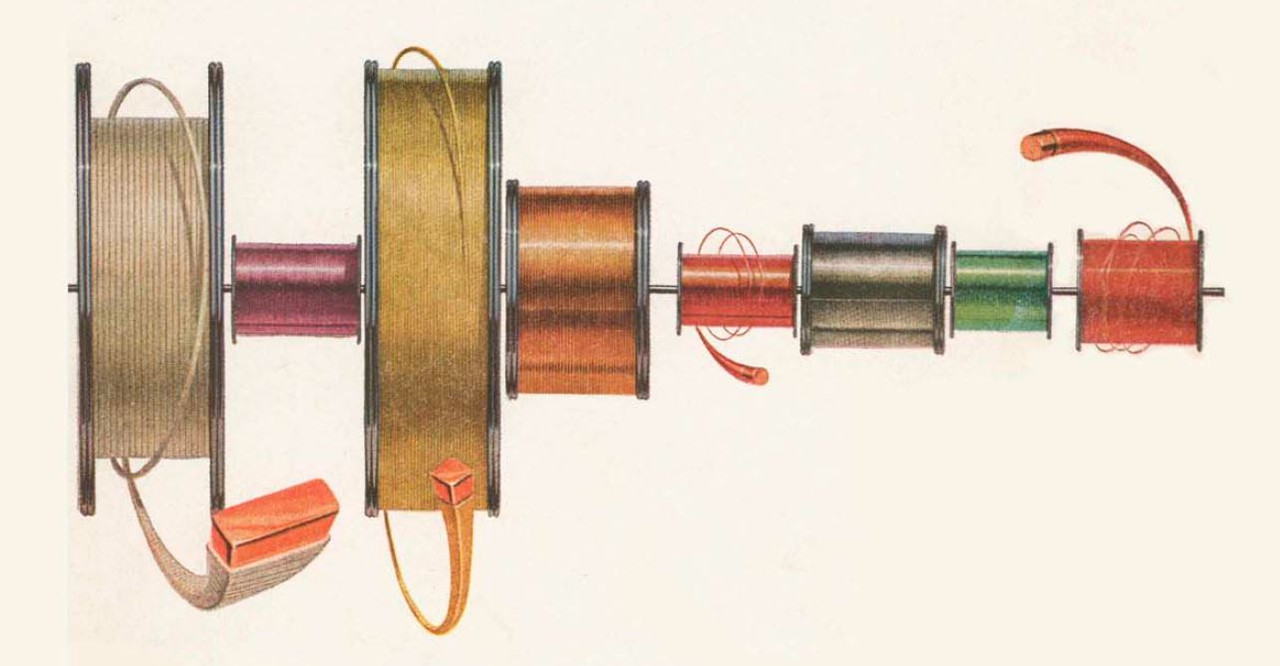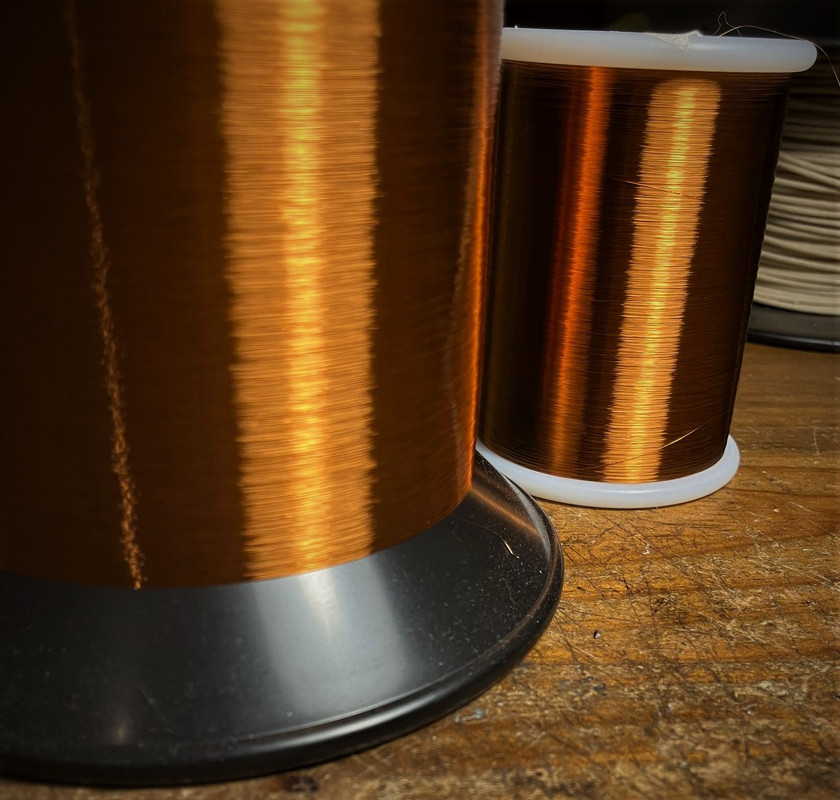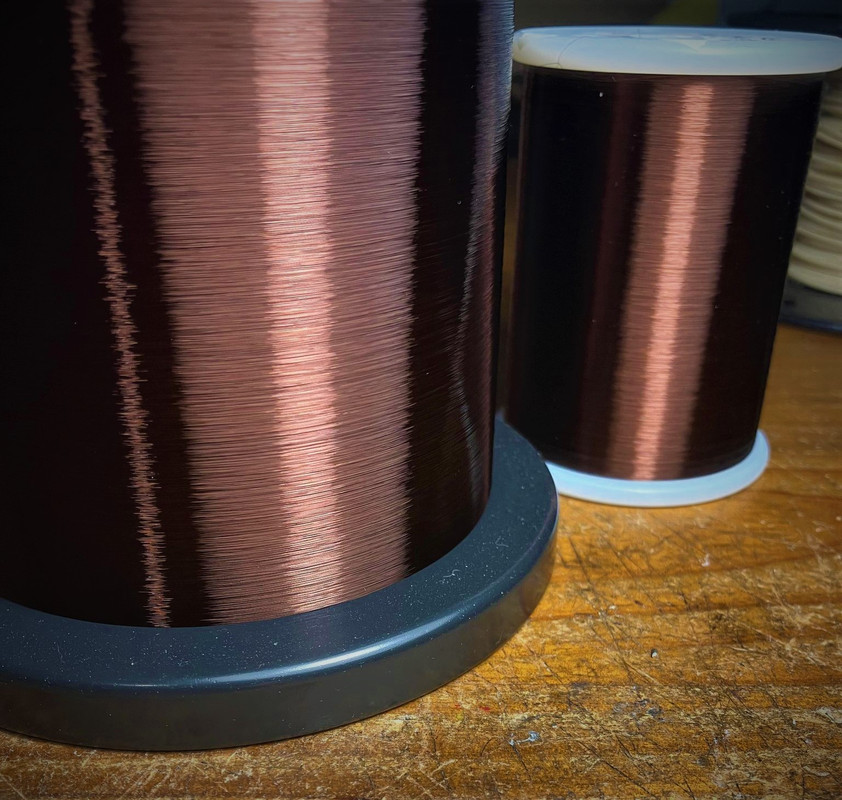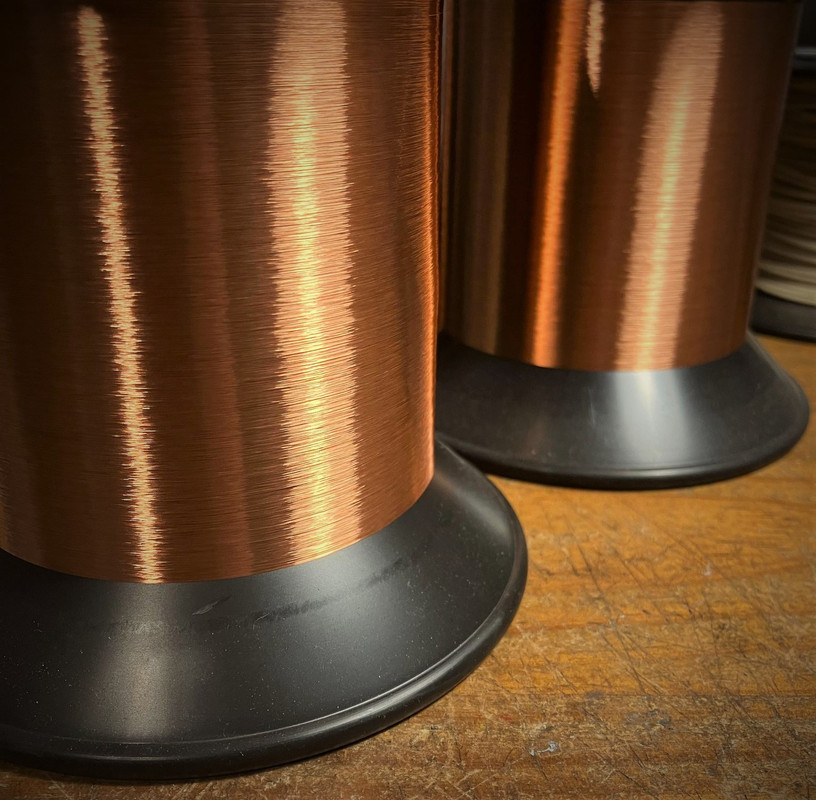A bit about Coil Wire
There are three main wire types we use to wind our guitar pickup coils. All share a copper conductor at the core, but the insulation type and insulation thickness vary.
Formvar wire
1 – Formvar or “FV” (Polyvinyl Formal) insulation is a golden coloured thermoplastic resin. Current industry uses include; as a backing for magnetic tape, support film in electron microscopy, and an ingredient in adhesive manufacture for the aerospace industry. Copper wire can be insulated (coated/enameled) with Formvar for use in coil winding. Formvar is a costly material to produce even before it is applied to copper wire as insulation. When used in guitar pickups, Formvar insulation is often applied in double-thickness and this assists the pickup maker in retaining a certain pleasing treble or “bell-like” clarity. Formvar is not widely used in the coil winding industry and is a specialist wire type, mostly reserved for making guitar pickups. Formvar enameled copper wire was used in the 50’s on Strat pickups until mid-1964. Our ’54 and ’59 Strat sets use Formvar wire manufactured by Elektrisola USA.
Plain Enamel wire
2 – “Plain Enamel” or “PE” (Oleo-resinous enamel) insulation has a purplish/burgundy appearance and was one of the first types of insulation used to insulate a bare copper wire. PE wires are manufactured to single-build dimensional standards allowing more turns of wire to be wound into a given space (vs Formvar). In a guitar pickup, this property can assist in positioning parts of a coil closer to the magnets, adding more “punch” to the sound. PE has unique dielectric properties (K*) among other wire types. PE is no longer widely used in the coil winding industry and has been replaced by poly wire types in most modern applications. PE was used in the early 50’s on Tele, P-90 and PAF pickups, and on Strat from mid-1964. PE also shows up in early Bass pickups. Our Purple Voodoo,’65 Strat, ’62 Bass sets, Sovereign ’59 humbuckers and J-90 sets all use genuine Elektrisola Plain Enamel coil wire.
Poly wire
3 – “Poly-Nylon” is the current industry standard for most coil winding applications. There are many types of poly wire, too many to list. It is used in transformers, relays, solenoids, small motors, watch coils and instruments. It has a copper coloured appearance. Mass production economy of scale makes Poly-Nylon a more affordable choice for coil winding.
Our Fat Toney and Sweet '62 sets both use poly wire Elektrisola USA and from Hitachi, made in Japan.
As modern industry is not requiring the bulk manufacture of Formvar or Plain Enamel, the economy of scale is not the same as it is for modern Poly wire types, positioning plain enamel wire and Formvar among the most expensive wire types available, costing around 400% more than its Poly-Nylon counterparts.
Different insulation thicknesses are available, and we source them from different suppliers both in Australia and in the United States.
Compare Apples with Apples (look out for fakes)
We have seen some cheaper wire claiming to be “Plain Enamel” or “Formvar”, so we purchased some for testing. Our testing has showed that this is a poly wire with insulation coloured to appear like more expensive insulation types. Many of the “plain enamel” and “Formvar” pickups you see for bargain prices on auction sites are wound with this coloured poly wire. True plain enamel has a burgundy hue in the right light; it also measures and sounds very different to poly. True Formvar has a very organic feeling coating and the treble response is again, different to poly.
It takes the same amount of time to make pickups no matter which wire we use, so we use only genuine Elektrisola wire and Hitachi wire from reputable dealers.
(K*) = Kappa or Dielectric Constant
do different wire insulation types sound different?
Yes. The difference in tone comes from at least two factors affecting the insulation - insulation thickness and insulation type. These factors vary and the figures are calculated by measuring dielectric constant. Dielectric constant within a guitar pickup affects dielectric losses, which are a frequency dependent value. In short, insulation type will affect the final tone you'll get.
We don't just take any wire type and feed it into any pickup design, each pickup is designed, prototyped and tested, from the ground up to sound great. Wire type influences all other factors we consider when designing the best sounding and performing guitar pickups for our customers.
We asked Elektrisola, a leading manufacturer of magnet wire, to explain the difference in wire insulation:
"Dielectric constant
The relative permittivity εr of a material is its absolute permittivity expressed as a ratio relative to the vacuum permittivity. Permittivity is a material property that affects the Coulomb force between two point charges in the material. Relative permittivity is the factor by which the electric field between the charges is decreased relative to vacuum which is 1 by definition. Relative permittivity is also commonly known as dielectric constant.
Typical values for our wires are listed below. All measurements were performed with a tangent delta tester at 1 kHz.
P155 (Poly) 3.8
Formvar 7.40
Plain Enamel 4.98
This technical information about insulation of magnet wire is to the best of our knowledge.
Yours sincerely
Dr. Gerd Schildbach
GmbH & Co. KG
ELEKTRISOLA"



